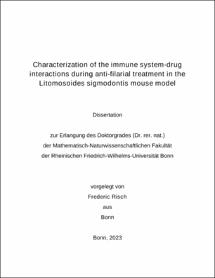Risch, Frederic: Characterization of the immune system-drug interactions during anti-filarial treatment in the Litomosoides sigmodontis mouse model. - Bonn, 2024. - Dissertation, Rheinische Friedrich-Wilhelms-Universität Bonn.
Online-Ausgabe in bonndoc: https://nbn-resolving.org/urn:nbn:de:hbz:5-73635
Online-Ausgabe in bonndoc: https://nbn-resolving.org/urn:nbn:de:hbz:5-73635
@phdthesis{handle:20.500.11811/11213,
urn: https://nbn-resolving.org/urn:nbn:de:hbz:5-73635,
author = {{Frederic Risch}},
title = {Characterization of the immune system-drug interactions during anti-filarial treatment in the Litomosoides sigmodontis mouse model},
school = {Rheinische Friedrich-Wilhelms-Universität Bonn},
year = 2024,
month = jan,
note = {Filarial nematodes can cause debilitating diseases such as lymphatic filariasis and onchocerciasis. Both diseases are included in the list of neglected tropical diseases as defined by the World Health Organization (WHO) and targeted for elimination. There are currently no approved drugs available that can effectively clear the adult worms (= macrofilaricide) in a timely manner. Potential macrofilaricidal compounds that are in development include both directly acting drugs such as the benzimidazole oxfendazole (OXF) as well as indirectly acting drugs like corallopyronin A (CorA). OXF is currently under preparation for phase 2 clinical trials in filariasis patients while CorA is under preparation for phase 1 clinical trials.
This thesis aimed to investigate the immune system’s role during treatment with OXF, flubendazole (FBZ) and CorA, and explore the potential to boost the treatment efficacy via stimulation of the immune system (combination therapy) in a rodent model system. Wild type (WT) BALB/c, eosinophil-deficient ΔdblGata1, IL-4r/IL-5-/-, antibody-deficient µMT and B cell, T cell, and ILC-deficient Rag2/IL-2rγ-/- mice were infected with the rodent filaria Litomosoides sigmodontis and treated with OXF, FBZ and CorA starting at 35 days post infection (dpi). In the second part, WT mice were treated for a reduced duration with a combination of OXF and IL-4, IL-5, or IL-33.
A 5 day-treatment of WT mice reduced the median adult worm burden by up to 94% (OXF, administered orally) and 100% (FBZ, administered subcutaneously) compared to vehicle controls. In contrast, treatment efficacy was lower in all immunodeficient strains with a reduction of up to 90% (OXF) and 75% (FBZ) for ΔdblGata1, 50% and 92% for IL-4r/IL-5-/-, 64% and 78% for µMT or 0% for Rag2/IL-2rγ-/- . The effect of OXF on microfilaremia and embryogenesis displayed a similar pattern, while FBZ’s ability to prevent microfilaremia was independent of the host’s immune status. Furthermore, flow cytometric analysis revealed strain- and treatment-specific immunological changes. Treatment with CorA did not result in the clearance of adult worms in either WT or immunodeficient mice and the depletion of Wolbachia was unaffected by the lack of eosinophils, IL-4 receptor or IL-5.},
url = {https://hdl.handle.net/20.500.11811/11213}
}
urn: https://nbn-resolving.org/urn:nbn:de:hbz:5-73635,
author = {{Frederic Risch}},
title = {Characterization of the immune system-drug interactions during anti-filarial treatment in the Litomosoides sigmodontis mouse model},
school = {Rheinische Friedrich-Wilhelms-Universität Bonn},
year = 2024,
month = jan,
note = {Filarial nematodes can cause debilitating diseases such as lymphatic filariasis and onchocerciasis. Both diseases are included in the list of neglected tropical diseases as defined by the World Health Organization (WHO) and targeted for elimination. There are currently no approved drugs available that can effectively clear the adult worms (= macrofilaricide) in a timely manner. Potential macrofilaricidal compounds that are in development include both directly acting drugs such as the benzimidazole oxfendazole (OXF) as well as indirectly acting drugs like corallopyronin A (CorA). OXF is currently under preparation for phase 2 clinical trials in filariasis patients while CorA is under preparation for phase 1 clinical trials.
This thesis aimed to investigate the immune system’s role during treatment with OXF, flubendazole (FBZ) and CorA, and explore the potential to boost the treatment efficacy via stimulation of the immune system (combination therapy) in a rodent model system. Wild type (WT) BALB/c, eosinophil-deficient ΔdblGata1, IL-4r/IL-5-/-, antibody-deficient µMT and B cell, T cell, and ILC-deficient Rag2/IL-2rγ-/- mice were infected with the rodent filaria Litomosoides sigmodontis and treated with OXF, FBZ and CorA starting at 35 days post infection (dpi). In the second part, WT mice were treated for a reduced duration with a combination of OXF and IL-4, IL-5, or IL-33.
A 5 day-treatment of WT mice reduced the median adult worm burden by up to 94% (OXF, administered orally) and 100% (FBZ, administered subcutaneously) compared to vehicle controls. In contrast, treatment efficacy was lower in all immunodeficient strains with a reduction of up to 90% (OXF) and 75% (FBZ) for ΔdblGata1, 50% and 92% for IL-4r/IL-5-/-, 64% and 78% for µMT or 0% for Rag2/IL-2rγ-/- . The effect of OXF on microfilaremia and embryogenesis displayed a similar pattern, while FBZ’s ability to prevent microfilaremia was independent of the host’s immune status. Furthermore, flow cytometric analysis revealed strain- and treatment-specific immunological changes. Treatment with CorA did not result in the clearance of adult worms in either WT or immunodeficient mice and the depletion of Wolbachia was unaffected by the lack of eosinophils, IL-4 receptor or IL-5.},
url = {https://hdl.handle.net/20.500.11811/11213}
}






